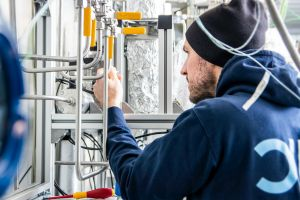Mar 26 2020
The goal of the NECOC (NEgative Carbon dioxide to Carbon) research project carried out at the Karlsruhe Institute of Technology (KIT) is to construct a special test facility for actively bringing down atmospheric carbon dioxide (CO2).
 In the NECOC research project, an integrated pilot plant is being built to test a new process for reducing the greenhouse gas CO2 in the atmosphere. The process will produce carbon black—a high-quality, solid carbon. Image Credit: Moritz Leg.
In the NECOC research project, an integrated pilot plant is being built to test a new process for reducing the greenhouse gas CO2 in the atmosphere. The process will produce carbon black—a high-quality, solid carbon. Image Credit: Moritz Leg.
The first-ever container-scale facility of this kind in the world is to transform CO2 in ambient air into extremely pure carbon black powder that can be utilized as a resource in the industry.
The project collaborators are INERATEC GmbH, a KIT spinoff, and Climeworks, an ETH Zurich spinoff. The research project has been scheduled for three years and financially supported by the Federal Ministry for Economic Affairs and Energy (BMWi) with a total of EUR 1.5 million.
The global community is committed to the Paris climate agreement of 2015, the goal of which is to restrict global warming to less than 2 °C by the end of the century. However, to reach this goal, global measures to bring down greenhouse gas emissions will have to be complemented by solutions for eliminating the CO2 already emitted into the atmosphere.
Our project approach consists of removing CO2 from the atmosphere and converting it into carbon black, i.e. highly pure carbon in powder form. In this way, a hazardous greenhouse gas will be converted into a raw material for high-tech applications. Carbon black can be used in electronics, printing, or construction.
Thomas Wetzel, Professor, Institute of Thermal Process Engineering
Wetzel is also the Head of the KALLA Karlsruhe Liquid Metal Laboratory of the Institute for Thermal Energy Technology and Safety.
Test Facility Combines Several Process Steps
The test facility to be established as part of the NECOC research project will include the following procedures: An adsorber is used to first capture CO2 from ambient air (direct air capture, or DAC). It is then converted along with renewable hydrogen into water and methane in a microstructured reactor.
The generated methane acts as a carbon carrier in the downstream process and is introduced into a bubble reactor loaded with liquid tin. When the methane bubbles rise, a pyrolysis reaction occurs, through which methane is disintegrated into its components.
One of the constituents is hydrogen, which directly fed back to methanation, and the other one is solid carbon, which is in the form of microgranular powder, that is, carbon black.
The scientists who were involved in the study have already analyzed and developed the process steps up to the laboratory scale.
We know the individual modules well. However, they have never been realized together in an integrated facility so far. This is the first time worldwide. Skillful integration of the process modules and correct process conduct will be decisive for the energy efficiency of the process and the quality of the carbon black product.
Dr Benjamin Dietrich, Project Coordinator of NECOC, Institute of Thermal Process Engineering
Dietrich continued, “The major advantage over previously proposed concepts to reduce atmospheric CO2, such as carbon capture and storage methods (CCS) to store CO2 in deep rock layers, consists in this end product.”
Solid carbon is far less difficult to handle than CO2 and can even be used as a resource. So far, carbon black has been produced mainly from fossil petroleum. That is why our process represents a technological approach for a sustainable future in several respects. It combines the direct contribution to solving the climate problem with a process for post-fossil resource supply.
Dr Benjamin Dietrich, Project Coordinator of NECOC, Institute of Thermal Process Engineering
The test facility will be set up on the KIT premises. The objective of the facility is to operate over a longer period. Plans have been proposed for future extensions of the facility to enhance the performance for each container and to allow parallel operation of several facilities.
The partners of KIT in the NECOC research project are the Karlsruhe Liquid Metal Laboratory (KALLA), a facility of the Institute for Thermal Energy Technology and Safety (ITES), and the Institute of Thermal Process Engineering (TVT).
Apart from coordinating the project and operating the facility KIT will also contribute to the pyrolysis technology.